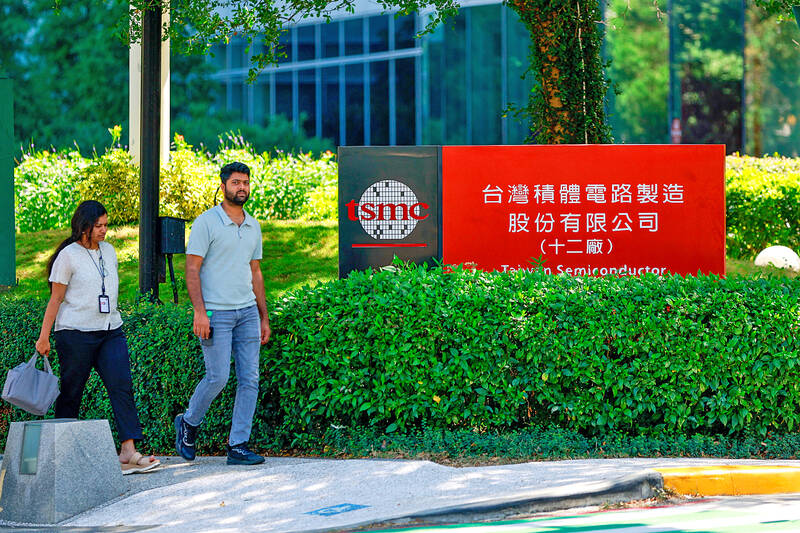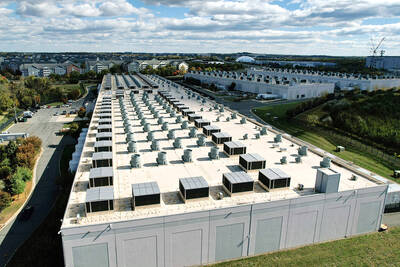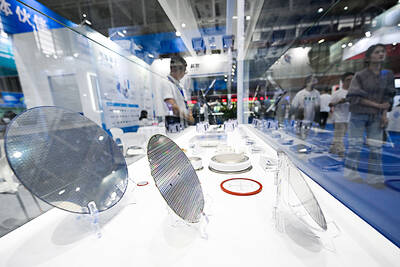Taiwan Semiconductor Manufacturing Co (TSMC, 台積電) yesterday raised its full-year revenue growth outlook after posting record profit for last quarter, despite growing market concern about an artificial intelligence (AI) bubble.
The company said it expects revenue to expand about 35 percent year-on-year, driven mainly by faster-than-expected demand for leading-edge chips for AI applications.
The world’s biggest contract chipmaker in July projected that revenue this year would expand about 30 percent in US dollar terms.

Photo: Ritchie B. Tongo, EPA
The company also slightly hiked its capital expenditure for this year to US$40 billion to US$42 billion, compared with US$38 billion to US$42 billion it set previously.
“AI demand actually continues to be very strong. It is stronger than we thought three months ago,” TSMC chairman and CEO C.C. Wei (魏哲家) said in an earnings call.
The company expects the growth of AI accelerators to slightly surpass its previous estimate of 45 percent annually during the 2024-2029 period, Wei said.
The growth would remain “dramatic and positive,” even if the Chinese market became inaccessible for customers, he said.
Nvidia Corp, a major TSMC customer, is facing challenges in exporting AI chips to China due to an escalating rivalry between the US and China.
“Everything related to [AI] like front-end and back-end capacity is very tight. We are working very hard to make sure that the [demand-supply] gap will be narrowed,” Wei said. “We are still working hard to increase the capacity in 2026.”
TSMC is preparing to speed up deployment of its 2-nanometer and more advanced technologies in Arizona, aiming to catch up with robust demand for leading-edge chips for smartphones, AI and high-performance computing applications, he said.
The company is close to securing more land in Arizona for capacity expansions, he said.
TSMC had planned to utilize 2-nanometer process technology to produce advanced chips at its third factory in Arizona, which is under construction, but it yesterday said it might start using 2-nanometer technology to produce advanced chips at its second fab in the US, or adopt both 3-nanometer and 2-nanometer technologies.
It is part of TSMC’s US$165 billion US investment plan, after which the chipmaker expects about 30 percent of its advanced chips to come from overseas fabs, it said.
TSMC yesterday posted record net profit of NT$452.3 billion (US$14.75 billion) for the third quarter, up 13.6 percent sequentially and surging 39.1 percent from a year earlier. Earnings per share rose to NT$17.44, from NT$15.36 in the second quarter and NT$12.54 percent the previous year.
The company expects revenue for this quarter to be US$32.2 billion to US$33.4 billion, fueled by robust demand for 3-nanometer and 5-nanometer chips.
That forecast indicated that revenue this quarter would edge up 0.91 percent sequentially, or 24.26 percent year-on-year, in the best-case scenario. At the worst, revenue would drop 2.72 percent quarterly, or grow 19.79 percent annually.
“Recent developments in the AI market continue to be very positive. The explosive growth in token volume demonstrates increasing consumer AI model adoption, which means more and more computation is needed, leading to more leading-edge silicon demand,” Wei said.
Gross margin is expected to rise to 59 percent to 61 percent this quarter, from 59.5 percent in the previous quarter, under a less volatile foreign exchange environment, the company said.

Taiwan’s exports soared 56 percent year-on-year to an all-time high of US$64.05 billion last month, propelled by surging global demand for artificial intelligence (AI), high-performance computing and cloud service infrastructure, the Ministry of Finance said yesterday. Department of Statistics Director-General Beatrice Tsai (蔡美娜) called the figure an unexpected upside surprise, citing a wave of technology orders from overseas customers alongside the usual year-end shopping season for technology products. Growth is likely to remain strong this month, she said, projecting a 40 percent to 45 percent expansion on an annual basis. The outperformance could prompt the Directorate-General of Budget, Accounting and

The demise of the coal industry left the US’ Appalachian region in tatters, with lost jobs, spoiled water and countless kilometers of abandoned underground mines. Now entrepreneurs are eyeing the rural region with ambitious visions to rebuild its economy by converting old mines into solar power systems and data centers that could help fuel the increasing power demands of the artificial intelligence (AI) boom. One such project is underway by a non-profit team calling itself Energy DELTA (Discovery, Education, Learning and Technology Accelerator) Lab, which is looking to develop energy sources on about 26,305 hectares of old coal land in

Netflix on Friday faced fierce criticism over its blockbuster deal to acquire Warner Bros Discovery. The streaming giant is already viewed as a pariah in some Hollywood circles, largely due to its reluctance to release content in theaters and its disruption of traditional industry practices. As Netflix emerged as the likely winning bidder for Warner Bros — the studio behind Casablanca, the Harry Potter movies and Friends — Hollywood’s elite launched an aggressive campaign against the acquisition. Titanic director James Cameron called the buyout a “disaster,” while a group of prominent producers are lobbying US Congress to oppose the deal,

Two Chinese chipmakers are attracting strong retail investor demand, buoyed by industry peer Moore Threads Technology Co’s (摩爾線程) stellar debut. The retail portion of MetaX Integrated Circuits (Shanghai) Co’s (上海沐曦) upcoming initial public offering (IPO) was 2,986 times oversubscribed on Friday, according to a filing. Meanwhile, Beijing Onmicro Electronics Co (北京昂瑞微), which makes radio frequency chips, was 2,899 times oversubscribed on Friday, its filing showed. The bids coincided with Moore Threads’ trading debut, which surged 425 percent on Friday after raising 8 billion yuan (US$1.13 billion) on bets that the company could emerge as a viable local competitor to Nvidia